TOYOTA AVALON TRD 2020 QUICK TAKES
TOYOTA AVALON TRD 2020 QUICK TAKES
NASCAR fans are very familiar with the TRD-developed Toyota Camrys that compete in the Monster Energy NASCAR Cup Series. They see them on the track, and in the winner’s circle, like when the NASCAR Camrys took the top three spots in the Gander RV 400 at Pocono Raceway.
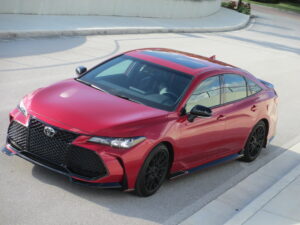 Fans can also experience track-inspired Camrys on the street with the first-ever Camry TRD. Now joining the TRD family is the Avalon TRD, creating the best-handling and boldest-looking Toyota sedans ever. Both vehicles receive unique styling developed by Calty Design, Toyota’s U.S. design center.
Fans can also experience track-inspired Camrys on the street with the first-ever Camry TRD. Now joining the TRD family is the Avalon TRD, creating the best-handling and boldest-looking Toyota sedans ever. Both vehicles receive unique styling developed by Calty Design, Toyota’s U.S. design center.
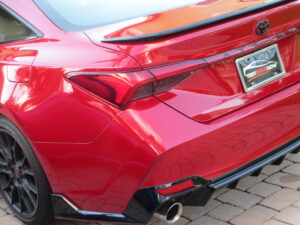 The 2020 Camry and Avalon are the first Toyota sedans to earn the TRD badge with a comprehensive, track-tuned performance enhancement.
The 2020 Camry and Avalon are the first Toyota sedans to earn the TRD badge with a comprehensive, track-tuned performance enhancement.
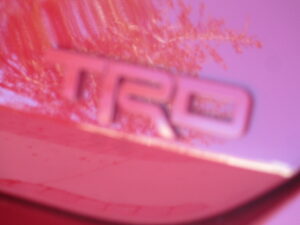 TRD is Toyota Racing Development, the carmaker’s motorsports division which is also responsible for developing performance-enhanced production models and parts and accessories.
TRD is Toyota Racing Development, the carmaker’s motorsports division which is also responsible for developing performance-enhanced production models and parts and accessories.
 The Camry TRD and Avalon TRD models have arrived in dealerships, a great way to wrap up the 40th anniversary year of TRD U.S.A. (Fun fact: the top song on Billboard’s year-end pop singles music chart in 1979 was “My Sharona” by The Knack. Yes, it was that long ago.)
The Camry TRD and Avalon TRD models have arrived in dealerships, a great way to wrap up the 40th anniversary year of TRD U.S.A. (Fun fact: the top song on Billboard’s year-end pop singles music chart in 1979 was “My Sharona” by The Knack. Yes, it was that long ago.)
 The new TRD sedans will have more company, too. The 2020 RAV4 TRD Off-Road model is the first-ever TRD-enhanced version of America’s best-selling compact crossover SUV.
The new TRD sedans will have more company, too. The 2020 RAV4 TRD Off-Road model is the first-ever TRD-enhanced version of America’s best-selling compact crossover SUV.
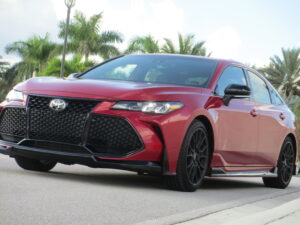 And, the TRD Handling Package for the 86 sports car inherits the track-tuned chassis hardware and tuning from the 2019 Toyota 86 TRD Edition, which was the first passenger car to wear the TRD badge.
And, the TRD Handling Package for the 86 sports car inherits the track-tuned chassis hardware and tuning from the 2019 Toyota 86 TRD Edition, which was the first passenger car to wear the TRD badge.
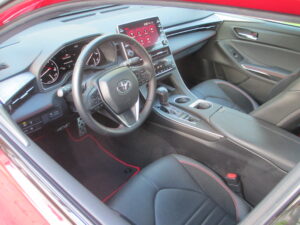 “Over its four decades, the equity behind the TRD brand has grown massively,” says Dave Wilson, president of TRD U.S.A. “TRD has played a direct role in Toyota and Lexus winning the most prestigious motorsports events in America – the Rolex 24 at Daytona, Baja 1000, Pikes Peak Hill Climb, Indy 500, Daytona 500 and the Chili Bowl Nationals, to name a few. With the tremendous success TRD and Toyota have enjoyed in NASCAR, racing TRD-powered Camrys, a Camry TRD edition seemed like a natural.”
“Over its four decades, the equity behind the TRD brand has grown massively,” says Dave Wilson, president of TRD U.S.A. “TRD has played a direct role in Toyota and Lexus winning the most prestigious motorsports events in America – the Rolex 24 at Daytona, Baja 1000, Pikes Peak Hill Climb, Indy 500, Daytona 500 and the Chili Bowl Nationals, to name a few. With the tremendous success TRD and Toyota have enjoyed in NASCAR, racing TRD-powered Camrys, a Camry TRD edition seemed like a natural.”
Racing Improves the Breed
Just as Toyota’s off-road-ready TRD pickups and SUVs inherit their performance heritage from a long line of championship off-road and desert race trucks, the Camry TRD and Avalon TRD reflect four decades of championship-winning auto racing history. 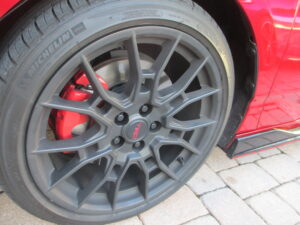 The 2020 Camry TRD and Avalon TRD models blend V6 performance with greater agility, precision and body control, all packaged with attention-grabbing TRD design and everyday drivability.
The 2020 Camry TRD and Avalon TRD models blend V6 performance with greater agility, precision and body control, all packaged with attention-grabbing TRD design and everyday drivability.
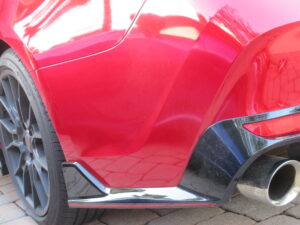 “One of the keys to the success in every TRD edition vehicle is the commitment to authentic performance improvement, not just styling,” says Wilson. “If you see a TRD-badged car or truck, you can be assured it is not just a decal package.
“One of the keys to the success in every TRD edition vehicle is the commitment to authentic performance improvement, not just styling,” says Wilson. “If you see a TRD-badged car or truck, you can be assured it is not just a decal package.
 There is a tangible performance improvement – suspension, exhaust, intake tuning, etc.”
There is a tangible performance improvement – suspension, exhaust, intake tuning, etc.”
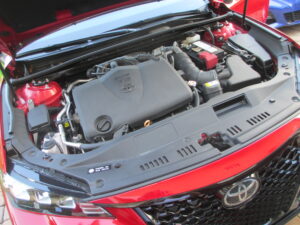 These exciting new performance sedans embody TRD’s holistic approach to vehicle enhancement. Notably, both are powered by Toyota’s renowned 301 horsepower DOHC 3.5-liter V6 engine teamed to an 8-speed automatic transmission with sport mode and paddle shifters.
These exciting new performance sedans embody TRD’s holistic approach to vehicle enhancement. Notably, both are powered by Toyota’s renowned 301 horsepower DOHC 3.5-liter V6 engine teamed to an 8-speed automatic transmission with sport mode and paddle shifters.
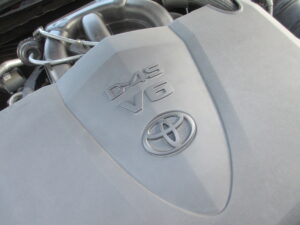 The V6 exhales through a specially tuned TRD cat-back dual exhaust, giving both models a throatier idle and acceleration sound.
The V6 exhales through a specially tuned TRD cat-back dual exhaust, giving both models a throatier idle and acceleration sound.
 The Camry TRD and Avalon TRD models are as sophisticated and comfortable in their road manners as they are quick and agile. Thicker underbody braces increase torsional rigidity. TRD coil springs lower both sedans by 0.6 inches for a reduced center of gravity, while stiffer TRD stabilizer bars increase roll stiffness.
The Camry TRD and Avalon TRD models are as sophisticated and comfortable in their road manners as they are quick and agile. Thicker underbody braces increase torsional rigidity. TRD coil springs lower both sedans by 0.6 inches for a reduced center of gravity, while stiffer TRD stabilizer bars increase roll stiffness.
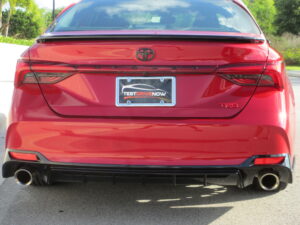 A unique set of TRD shock absorbers along with Bridgestone Potenza 235/40R19 summer tires (available only on Camry TRD) complete a chassis package that improves body control, handling agility, and steering precision.
A unique set of TRD shock absorbers along with Bridgestone Potenza 235/40R19 summer tires (available only on Camry TRD) complete a chassis package that improves body control, handling agility, and steering precision.
 The 19 x 8.5 inch matte-black alloy wheels on both models reduce unsprung mass by 18 pounds compared to the 19-inch wheels on the Camry and Avalon XSE models.
The 19 x 8.5 inch matte-black alloy wheels on both models reduce unsprung mass by 18 pounds compared to the 19-inch wheels on the Camry and Avalon XSE models.
 Front brakes for both models are larger with 12.9-inch diameter rotors and dual-piston calipers compared to 12.0-inch rotors and single-piston calipers used on Camry and Avalon XSE grades. Brake performance was also tuned to provide more direct feedback, matching the sporty dynamics of the vehicles.
Front brakes for both models are larger with 12.9-inch diameter rotors and dual-piston calipers compared to 12.0-inch rotors and single-piston calipers used on Camry and Avalon XSE grades. Brake performance was also tuned to provide more direct feedback, matching the sporty dynamics of the vehicles.
The TRD Look
Like all TRD vehicles, the 2020 Camry and Avalon TRD models are designed to stand apart. Calty Design Research, Toyota’s design studio, gave both cars striking aero elements, taking advantage of the edgier designs of the new-generation Camry and Avalon and aggressive stance of the TRD-modified chassis. On both models, red pinstriping, red-painted brake calipers, and red TRD badging complete the road-hungry look.
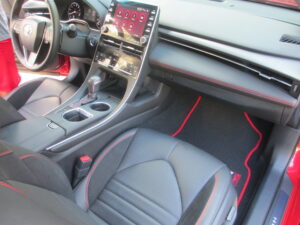 The Camry TRD is available in solid Midnight Black Metallic, or in one of three two-tone schemes featuring a Midnight Black Metallic Roof and Supersonic Red, Windchill Pearl or Celestial Silver.
The Camry TRD is available in solid Midnight Black Metallic, or in one of three two-tone schemes featuring a Midnight Black Metallic Roof and Supersonic Red, Windchill Pearl or Celestial Silver.
 The TRD treatment turns the Camry cabin into a sport sedan cockpit with just the right touch of sophisticated luxury. Black Sport SofTex®-trimmed front seats feature fabric inserts, red accents and red-stitched TRD embroidered headrests.
The TRD treatment turns the Camry cabin into a sport sedan cockpit with just the right touch of sophisticated luxury. Black Sport SofTex®-trimmed front seats feature fabric inserts, red accents and red-stitched TRD embroidered headrests.
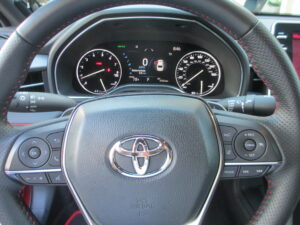 The leather-wrapped steering wheel also has red stitching, and even the seatbelts are red.
The leather-wrapped steering wheel also has red stitching, and even the seatbelts are red.
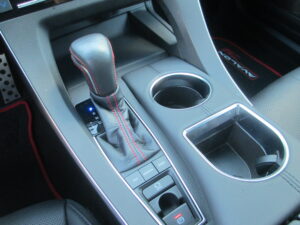 A shift knob with an embossed TRD logo,
A shift knob with an embossed TRD logo,
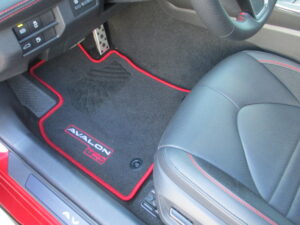 along with unique TRD floor
along with unique TRD floor
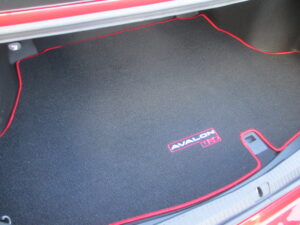 and trunk mats,
and trunk mats,
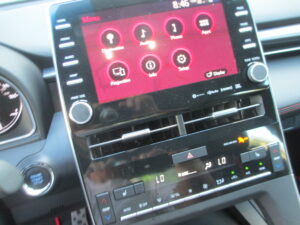 and a TRD multi-information display (MID) visual start exemplify the exceptionally high level of detail imparted by the TRD enhancement.
and a TRD multi-information display (MID) visual start exemplify the exceptionally high level of detail imparted by the TRD enhancement.
 The Avalon TRD is available in Supersonic Red, Windchill Pearl, Celestial Silver Metallic and Midnight Black Metallic. Its cabin features Black Sport SofTex-trimmed heated front seats with Ultra-suede inserts and red accents.
The Avalon TRD is available in Supersonic Red, Windchill Pearl, Celestial Silver Metallic and Midnight Black Metallic. Its cabin features Black Sport SofTex-trimmed heated front seats with Ultra-suede inserts and red accents.
Win on Sunday, Sell on Monday … It Works
Long before Toyota introduced the 1997 Tacoma TRD Off-Road, the first production model to feature TRD performance tuning, the motorsports division had filled a trophy case. TRD made the Toyota name ubiquitous on podiums in Mickey Thompson’s SCORE World Desert Championship, CART, ChampCar Endurance Series, IRL IndyCar and IMSA.
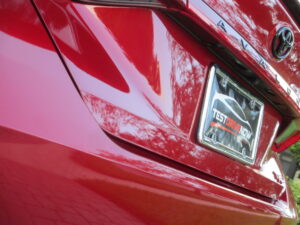 “This success has elevated the reputation and credibility of TRD among the U.S. motorsports industry and fan base,” Wilson says. “The increased integration of TRD across Toyota’s lineup of cars and trucks is an intentional strategy built upon our mutual success.”
“This success has elevated the reputation and credibility of TRD among the U.S. motorsports industry and fan base,” Wilson says. “The increased integration of TRD across Toyota’s lineup of cars and trucks is an intentional strategy built upon our mutual success.”
It All Began with a Sedan
After 23 years of the TRD logo adorning mainly trucks and SUVs, the Camry TRD and Avalon TRD models may have surprised some. Their addition to the line, however, seems entirely fitting, since Toyota’s racing history began with a sedan.
 In 1957, Toyota entered its first competition, campaigning a Toyopet Crown in the grueling 1957 Mobilgas Rally Around Australia. A new motorsport division called Toyota Sports Corner (Tosco) was started to manage the effort. Weighed down with spare parts and extra fuel, the Toyopet had just 48 horsepower to move its 3,700 pounds through the 19-day, 10,500-mile competition.
In 1957, Toyota entered its first competition, campaigning a Toyopet Crown in the grueling 1957 Mobilgas Rally Around Australia. A new motorsport division called Toyota Sports Corner (Tosco) was started to manage the effort. Weighed down with spare parts and extra fuel, the Toyopet had just 48 horsepower to move its 3,700 pounds through the 19-day, 10,500-mile competition.
Of the 87 cars that started the rally, 52 finished, among them the little Toyota in 47th place. It was a start. The following year, another Toyopet Crown won the inaugural Yomiuri Rally Around Japan. The rally performances helped establish Toyota’s reputation for durability.
Tosco’s victories continued in the 1960s, with three class wins in the inaugural Japanese Grand Prix in 1963 with a Toyota 2.0-liter Crown, 1.6-liter Corona, and 700cc Publica. In 1967, a Tosco-prepared Toyota 2000 GT sports car won the first Fuji 24-Hour Endurance Race and also set endurance records. Later, the Toyota 7 was the company’s first purpose-built sports racer, built for FIA Group 7 racing. With a 590-horsepower 5.0-liter V8, a squad of 7s swept the top four positions in the June 1968 Grand Cup of Suzuka. In 1969, the Toyota 7 won the championship in the World Challenge Cup Fuji 200-Mile.
The U.S. got a glimpse of Toyota’s competition spirit and ability in 1973. That year, the company entered a Corolla 1600 in Michigan’s Press-on-Regardless Rally and netted its first World Rally Championship (WRC) win.
TRD Begins a New Era
Tosco became Toyota Racing Development in 1976, with a mission to expand Toyota’s motorsports involvement and to develop parts and accessories for production cars. Three years later, its American wing, TRD U.S.A., opened with a similar mission. TRD looked at the entire motorsports landscape in America to see where Toyota vehicles could fit in and succeed.
In 1981, TRD partnered with Dan Gurney’s All-American Racers (AAR) team to compete in IMSA’s GTU (under 2.5-liter) class with the Celica, powered by a TRD-developed four-cylinder Toyota engine. By 1985, the collaboration had won 10 victories. They next entered the IMSA GTO class (over 2.5 liters) with a specially built, tube-frame Celica racecar, winning the 1987 championship — the first time a Japanese manufacturer had won that title.
In the early 1990s, Toyota sponsored Gurney’s AAR Eagle Mk. III car in IMSA’s GTP class, winning 21 out of the 27 races entered, and taking the 1993 championship.
Desert Runners
Toyota saw off-road racing as the ideal way to demonstrate the tough-as-nails durability of its compact pickup truck. In 1983, TRD teamed with Cal Wells III and his company, Precision Preparation, Inc. (PPI), to create one of the most successful partnerships in motorsports. With race vehicles based on Toyota’s pickup, Toyota/PPI dominated the Mickey Thompson (MTEG) stadium series and also won multiple SCORE World Desert races and championships with drivers Rod Millen and Ivan “Ironman” Stewart. In 1993 alone, Stewart won the Mint 400, Baja 500 and Baja 1000.
TRD took its off-road racing to TORC (The Off-Road Championships), and off-road successes continued.
Even before Toyota introduced the 1997 Tacoma TRD Off-Road, its dealers had been selling a line of TRD parts to enthusiasts to fortify their own vehicles. The success of the parts program and then the first factory TRD truck spurred Toyota to offer additional TRD models, eventually including today’s Tacoma TRD Sport for enhanced on-road performance and the Tacoma TRD Pro for all-out off-road capability.
For 2020, the line of TRD trucks and SUVs also includes the Tundra TRD Pro; 4Runner TRD Off-Road, Off Road Premium and Pro; Sequoia TRD Sport and Pro, and the first-ever RAV4 TRD Off-Road.
Toyota-Powered Open-Wheel Racing
In that same vein, the 2019 86 TRD Edition and now the 2020 Camry and Avalon TRD echo Toyota’s decades of success across the spectrum of tarmac racing. After IMSA, Toyota made a foray into open-wheel racing, including sponsoring and supplying engines for the Formula Atlantic series until 2004. TRD developed a version of the 4AG 1.6-liter engine used in Toyota’s MR2 sports car and Corolla GTS sport coupe, producing 240 horsepower and able to rev to 12,000 rpm. Among drivers in the series were Jacques Villeneuve, Jimmy Vasser and Patrick Carpentier.
Joining the upper echelon of open-wheel racing, Toyota’s engines won 38 races in CART and the IRL IndyCar Series. Critically, TRD engineered and built the engines for its cars in both series rather than buying and branding a third-party engine, as others had done. A TRD-powered car won the Indianapolis 500 in 2003.
American Institutions
By the 1990s, Toyota set its sights on two American motorsports institutions, NASCAR cup racing and NHRA drag racing. In 2000, Toyota became the first import car company to race in NASCAR, entering a V6 Celica in the Goody’s Dash Series. Four years later, in Toyota’s first year in the NASCAR Camping World Truck Series, Tundra drivers won 9 races and 13 pole positions.
That year, Toyota also won its first NHRA Funny Car victory at the Winternationals in Pomona, California, and four years later clinched the Funny Car championship. From 2010-2013, Toyota won four consecutive Top Fuel dragster championships.
By the early 2000-teens, Toyota had won championships in all three top NASCAR series. TRD USA engineers designed and built the V8 Tundra and V8 Camry engines for their respective NASCAR series. TRD USA has continued its astonishing run of victories, including in Daytona Prototype championship racing and USAC sprint cars.
Lexus has played a major role in TRD’s history, as well. Notably, Lexus-powered prototype-class cars competed in the Grand-Am Rolex Sports Car Series from 2004 to 2009, including winning the Rolex 24 at Daytona three years in a row, 2006-2008. For 2019, the newly formed AIM Vasser Sullivan (AVS) race team is campaigning two Lexus RC F GT3s in the IMSA WeatherTech SportsCar Championship.
40 Years … and Counting
TRD has made racing – and winning – in America’s most demanding motorsports an integral part of Toyota’s DNA for four decades. That drive to succeed is the impetus behind the largest range of TRD models that Toyota has ever offered, from a track-tuned lightweight sports car to trail-taming trucks and SUVs.
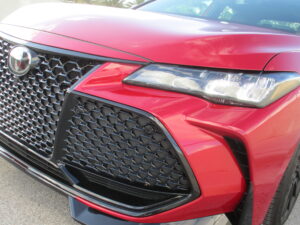 Now, TRD is challenging established sports sedans with the 2020 Camry and Avalon TRD models.
Now, TRD is challenging established sports sedans with the 2020 Camry and Avalon TRD models.
Here’s to a successful next 40 years.
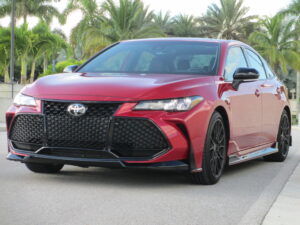 2020 TOYOTA AVALON TRD QUICK TAKES MSRP $42,300
2020 TOYOTA AVALON TRD QUICK TAKES MSRP $42,300
 AS SHOWN WITH PREMIUM AUDIO, DYNAMIC NAVIGATION, AND PAINT PROTECTION FILM: TOTAL VEHICLE PRICE $45,410
AS SHOWN WITH PREMIUM AUDIO, DYNAMIC NAVIGATION, AND PAINT PROTECTION FILM: TOTAL VEHICLE PRICE $45,410

 ACURA NSX 2020 TEST DRIVE
ACURA NSX 2020 TEST DRIVE TOYOTA HIGHLANDER HYBRID PLATINUM AWD
TOYOTA HIGHLANDER HYBRID PLATINUM AWD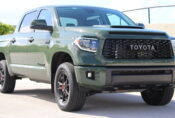 TOYOTA TUNDRA TRD PRO 2020 QUICK TAKES
TOYOTA TUNDRA TRD PRO 2020 QUICK TAKES